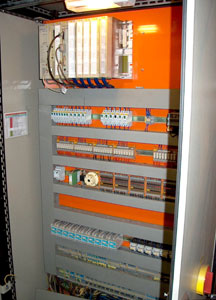3.3. Coaling control and regulation
 The system for coaling technology control and regulation uses a programmable logic controller (PLC) as the basic
control and a regulation unit to which all the external links are connected. The PLC can be designed centrally or
be made of several decentralised units interconnected by a communication line.
The system for coaling technology control and regulation uses a programmable logic controller (PLC) as the basic
control and a regulation unit to which all the external links are connected. The PLC can be designed centrally or
be made of several decentralised units interconnected by a communication line.
The system evaluates the correctness and coincidence of input and output signals, including failure states. All information regarding the state of the technology, failures and inconsonance, is automatically displayed to the operators by means of an operator control panel or a PC based working station with the monitor on which the whole technological process is displayed and controlled. The connection of the PLC with the operator control panel or the PC is made by a communication line.
The conditions and the logic of the fly-ash transport control is software-formed in the PLC; at the same time, the accuracy of the signals sent is checked by hardware which provides protection against improper manipulation or protection in case of failure to a part of the system.
Basic functions of the equipment:
1. Choosing a coaling route
- It is possible to use a coal transportation route.
2. Starting and switching-off the conveyers and pushers
- By means of the control buttons on the operator control panel or the PC monitor, it is possible to start/switch off individual conveyers individually or automatically start-up or put out of operation the entire selected coaling route.
3. Remote control of ploughs
- By means of electric controlled hydraulic distributors fitted at ploughs and the respective hydraulic power unit, it is possible to remote-control the individual ploughs by means of the PLC.
4. Conveyer interlocking
- The conveyers are locked to prevent undesirable starts.
5. Current and voltage measurement
- Current is measured in all the drives and their overloading is evaluated.
6. Coal weight, humidity and ash content measurement
- These measurements are made with a special instrument. The measured values are processed by the control system and can be sent in the form of a report to the superior system for further calculations and archiving. The connection of the measuring instruments with the PLC is made via a communication line, eventually via analogue and binary signals.
7. Signalling operation states
- Control switching over - local-remote
- Conveyer running
- Functions of alarm lights and horns
- Acquittance from the operators on the route
- Plough starting, i.e. specifying the place of coal dumping
- Belt breaking
- Emergency stopping (stranded wires)
8. Failure shutdown (failure of current, emergency stopping, belt breaking, drive overload)
9. Failure message display
- All the failures are displayed in the form of a printout on the operator control panel or PC monitor and they can be acquitted.

